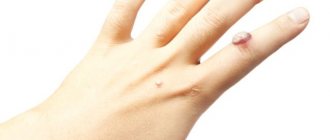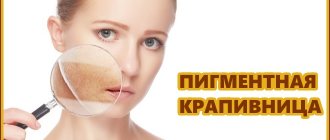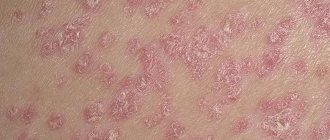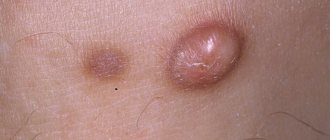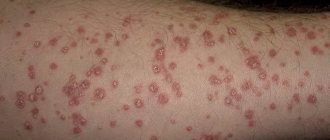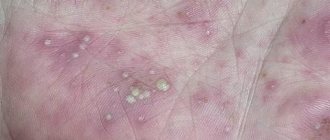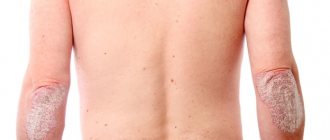Psoriasis is one of the most common dermatological lesions that are non-infectious in nature. Rashes with this disease are found on the legs, scalp and other parts of the body. It is also characterized by a chronic course with frequent exacerbations and periods of remission. Psoriasis on the legs occurs in many patients, and the main symptom is the formation of small patches with white or gray scales on the surface of the skin of the lower extremities. The pathology is not transmitted from one person to another, so it is impossible to become infected even through close contact with a patient.
Causes of psoriasis
According to statistical data, the disease develops equally in both men and women, and the patient’s age also does not play a significant role. However, the true causes of psoriasis on the legs and other areas of the human body are unknown to science, despite many clinical studies on this topic. The pathology is very complex, so it has not yet been possible to identify the main sources of its occurrence. But doctors have identified several risk factors that make the development of psoriatic disease most likely.
Predisposing factors:
- Frequent injury to the skin of the legs, particularly in the toes.
- Hereditary predisposition.
- Changes in hormonal levels.
- Frequent stressful situations, psycho-emotional stress.
- Infectious lesions of the body.
- Intoxication syndrome.
- Metabolic disorders.
- Excessive dryness of the skin of the legs.
- Improper foot care, use of low-quality cosmetics.
- Disturbances in the activity of the endocrine system.
- Chemical and thermal burns.
- Excessive hygiene.
- Alcohol intoxication.
- Varicose veins in the legs.
- Allergic reactions.
- Avitaminosis.
- Weakening of the body's immune defense.
- Helminthiases.
- Pathologies of lipid metabolism.
- Long-term use of medications.
Seasonal development of the disease is often observed. Causes of psoriasis that occurs on the legs, depending on the time of year:
- Exacerbation under the influence of ultraviolet radiation is summer psoriasis.
- Exacerbation under the influence of frost is winter psoriasis.
- Non-seasonal or year-round form of the disease, occurring without periods of remission.
The impact of leg psoriasis on quality of life
This seemingly non-life-threatening disease can nevertheless poison one’s existence so much that many patients complain of a complete lack of interest in life.
Physical discomfort, manifested through severe itching, pain or burning, which prevents a person from working, sleeping normally, caring for himself, or doing household chores, is aggravated by psychological worries and social problems.
It is difficult for such patients to get a job and it is impossible to play many sports. They often see aggressive social phobia towards themselves and are constantly in a state of stress. Many withdraw into themselves, in their small personal space and completely stop contact with other people, embarrassed by their appearance.
In addition, the treatment of this chronic disease is quite expensive and takes a lot of effort and time, which is also not conducive to study, work, personal life and successful socialization.
Types of disease
There are several types and forms of psoriasis of the legs:
- Plaque or ordinary psoriasis. This is the most common pathology in which silvery or gray plaques form on the skin of the legs, which unite with each other, forming large foci of inflammation. The disease usually affects the feet, legs and knees.
- Pustular generalized psoriasis is the most severe form of the disease, which is also called exudative psoriasis, Zumbusch's disease. Blisters filled with red liquid usually burst, and when infection occurs, there is a risk of suppuration. This type of pathology most often affects the lower parts of the legs (feet, legs, knees).
- Plantar pustulosis, in which purulent formations appear on the feet and tend to grow and spread. The main unfavorable point is the constant mechanical damage to the ulcers when walking.
- Acrodermatitis is a non-infectious form of psoriasis that occurs on the toes, feet and other parts of the lower extremities. The disease can cause delamination of the nail plates.
- Guttate psoriasis often occurs as a result of a previous streptococcal infection. Characterized by a pinpoint rash.
- Psoriatic arthropathy is an internal form of the disease that affects the knee and hip joints and connective tissue. The main symptom is swelling of the toes; with this pathology, there is a high probability of immobility and disability.
- Psoriasis of the flexor areas of the knees and hips.
Judging by clinical manifestations, psoriasis is divided into:
- Vulgar or ordinary.
- Erythrodermic.
- Pustular.
- Exudative.
- Arthropathic.
Choice of medications
In the initial stages, you can get by with more gentle medications. Dermatologists usually recommend ointments with a non-hormonal composition. The most popular of them are:
- Ichthyol;
- Tar;
- Naftalan.
They are able to eliminate inflammatory processes and play the role of antiseptics. These compositions have significant contraindications, so they can only be used according to the indications of a specialist. What drugs are we talking about:
- Salicylic acid, Cygnoderm. These compounds are capable of destroying the stratum corneum. They are classified as keratolytics. A characteristic property of these substances is the ability to exfoliate and resolve plaques.
- Antipsoriasis, Akrustal. They contain solid oil. These products have a regenerating, that is, restorative effect on the skin of the feet, softening it.
- Psorkutan. It contains an active form of vitamin D, which inhibits cell division. Due to this, the degree of inflammation and peeling is reduced.
If these medications fail to cope with the progression of the disease, switch to corticosteroids. They are used to treat the surface of defects. What groups are distinguished here:
- Low activity compounds. These include Prednisolone, Hydrocortisone. They act on the surface of the epidermis and are suitable for the initial manifestations of the disease.
- Moderately active. They combine Betamethasone, Decoderm. What ointments are advisable to use on rough areas of the skin, for example, the soles and knees.
- Highly active. These are Ultraveit, Galciderm, Dermovate. They must be prescribed when all previous classes of medications have failed to stop plaque enlargement.
It also happens that external dosage forms do not cope with the symptoms. In this case, you need to connect the tablets. The following drugs are considered the most effective:
- Cyclosporine. It suppresses the immune system and its activity in the body.
- Methotrexate. Does not allow epidermal cells to grow too much.
- Acitretin and Accutane are tablets from the group of retinoids, that is, derivatives of vitamin A. They are a necessary component for the regeneration of dermal cells.
Signs and stages of the disease
Psoriasis on the soles and other parts of the feet causes a lot of inconvenience, as the skin becomes cracked, itchy and itchy, and the extremities become swollen and painful.
The pathology in question is characterized by frequent alternation of periods of remissions and exacerbations, when all the symptoms first subside and then return with renewed vigor. The disease usually affects the following areas:
- Feet.
- Heels.
- Hips.
- Kneecaps.
Characteristic symptoms occur:
- At the initial stage, the manifestations of psoriasis on the legs are minor. Usually small pimples appear, which subsequently grow, begin to peel off, become covered with scales and merge into characteristic psoriatic plaques.
- As the pathology progresses, the rash rapidly spreads and the inflammatory process develops, accompanied by intense itching. Rashes are especially active in places where the integrity of the skin is damaged. The previously formed plaques begin to peel off greatly and become rough. Psoriasis is most severe on the feet, since the skin in this area is constantly exposed to mechanical stress as a result of walking.
- In the stationary stage, the disease does not progress, but does not go away; only intense exfoliation of the skin and itching are observed.
- The regressive stage is characterized by the disappearance of the rash and pigmentation of the epidermis in the affected areas.
Features of psoriasis on the legs can be seen and carefully examined in the corresponding photo.
Main symptoms
Very often psoriasis develops on the toes, between the legs, psoriasis on the feet or on the soles of the feet (soles), a photo of which you can see below. For the initial stage of the disease, single rashes are common, characterized by itching and a bright pink tint. Plaques protrude 1-2 millimeters above the surface of healthy skin. Most often they have a clear boundary. The entire surface of the plaque is covered with flaky skin - these are the so-called scales. They are easily scraped off the surface of the skin, after which they can crack and bleed.
The main symptom of psoriasis on the legs and other parts of the body is the presence of the so-called psoriatic triad. The phenomenon implies a combination of the following signs:
- Stearine stain - peeling of the surface of plaques in psoriasis, looks very similar to stearin.
- Terminal film - after removing the scales, a smooth shiny film is exposed; it is very thin and easily damaged.
- Bloody dew - due to damage or artificial removal of the film, drops of blood can be observed on the surface of the affected area of the dermis. In medical practice, this concept is called bloody dew.
Important! If you notice the first alarming symptoms on your body, it is recommended to consult a dermatologist. Early diagnosis and timely treatment helps reduce the risk of complications.
Treatment methods
Competent treatment of psoriasis involves the implementation of a whole range of therapeutic measures aimed at reducing pathological symptoms. Of great importance is careful foot hygiene, timely replacement of socks, disinfection and moisturizing of the skin, as well as the choice of suitable shoes that do not press, do not restrict movement and do not injure.
An approximate treatment regimen for psoriasis on the legs:
- External therapy, which involves the use of ointments, gels and other local agents for anti-inflammatory and regenerative effects.
- Systemic therapy is the administration of medications orally. Usually immunostimulants, antihistamines, hormonal medications, sedatives, vitamin complexes, cytostatics, etc. are prescribed.
- Traditional treatment is the use of natural remedies to reduce the symptoms of psoriasis.
- Physiotherapeutic procedures – phototherapy, laser irradiation, cryotherapy, etc.
- Compliance with a therapeutic diet.
Folk remedies for psoriasis on the legs
Folk remedies for psoriasis on the legs also bring quite good results. Popular recipes include the following:
Ointment based on egg yolks
To prepare the product you will need 2 large homemade eggs. They must be hard-boiled; only the yolks are used. They are placed on a hot frying pan without adding oil. The future ointment must be stirred constantly until an oily liquid forms. This product is used to lubricate plaques 2-3 times a day.
Systemic drugs
For moderate and severe disease, systemic medications are prescribed in the form of tablets and injection solutions.
It is recommended to treat psoriasis on the legs under the supervision of a doctor using the following medications:
- Antihistamines help cope with itching and reduce the inflammatory process (Zyrtec, Suprastin, Telfast, Claritin, Diazolin, etc.).
- If suppuration is present, antibiotics from the group of penicillins or cephalosporins are prescribed.
- Enterosgel, Filtrum-sti, Polysorb, activated or white carbon and other enterosorbents have a detoxifying effect.
- Diprospan in the form of an injection solution is used to treat severe forms of the disease. This is a hormonal drug that has a rapid therapeutic effect, but at the same time causes many side effects.
- Sandimmune is an immunosuppressant that helps quickly eliminate inflammation. The drug is highly toxic, so it is used only in a hospital setting under the watchful supervision of doctors.
- Methotrexate in the form of tablets and injection solutions is an analogue of folic acid that stops cell division and the spread of the psoriatic process. The drug cannot be used for pathologies of the kidneys and liver.
- Infliximab is indicated for the treatment of psoriatic arthritis.
- A solution of sodium thiosulfate cleanses the body of waste and toxins, has an anti-inflammatory effect, and restores immune defense.
Prevention
Psoriasis on the legs is a common form of dermatosis, causing many side diseases. To prevent relapses, you should:
- Wear clothes and shoes made from natural materials.
- Stick to proper nutrition.
- Treat allergic diseases in a timely manner.
- Maintain foot skin hygiene.
- Avoid injury and damage.
- Stop smoking and drinking alcohol.
Small nodular rashes on the surface of the skin are the first sign of the development of psoriasis. Dermatopathology cannot be cured, but with the timely use of targeted and symptomatic therapy, the inflammation quickly regresses. Proper nutrition and preventive measures reduce the likelihood of relapses by 25%.
Physiotherapy
To eliminate psoriasis on the feet and other parts of the legs, physiotherapeutic procedures are recommended as an addition to complex therapy. But they cannot be used in the acute stage; physiotherapy is indicated only for the stationary stage of the disease and during remission.
The most effective methods:
- Electrosleep.
- Ultraviolet irradiation.
- PUVA therapy.
- Magnetotherapy.
- Laser therapy.
- Ultrasound treatment.
- Laser photochemotherapy.
- Cryotherapy.
- Plasmapheresis.
- Darsonvalization.
Traditional methods
It is very important to properly care for feet affected by psoriasis. The skin with this pathology needs regular hydration and nutrition, especially after hygiene procedures.
To enhance the therapeutic effect of drug treatment, you can use several folk recipes to reduce inflammation and prevent the spread of the rash, to reduce itching and pain:
- Ointment made from melted propolis and butter.
- Crushed celandine mixed with Vaseline.
- Ointment made from propolis, vitamin A and warm butter.
- A mixture of honey and glycerin.
- A mixture of medical grease, bee honey and baby cream.
- A mixture of salicylic acid, birch tar and castor oil.
- Juice from celandine.
- Compress made from grated raw potatoes.
- Tea tree oil with essential extracts of lavender, rosemary, almond.
- A mixture of Kalanchoe juice, honey and eucalyptus oil.
- Compress with apple cider vinegar.
It is necessary to treat psoriasis both from the outside and from the inside, and to follow all medical recommendations for taking medications. Equally important is following a diet that involves excluding sweets, smoked foods, alcohol and other harmful foods from the diet. Increased consumption of fermented milk products and plant foods is recommended.



